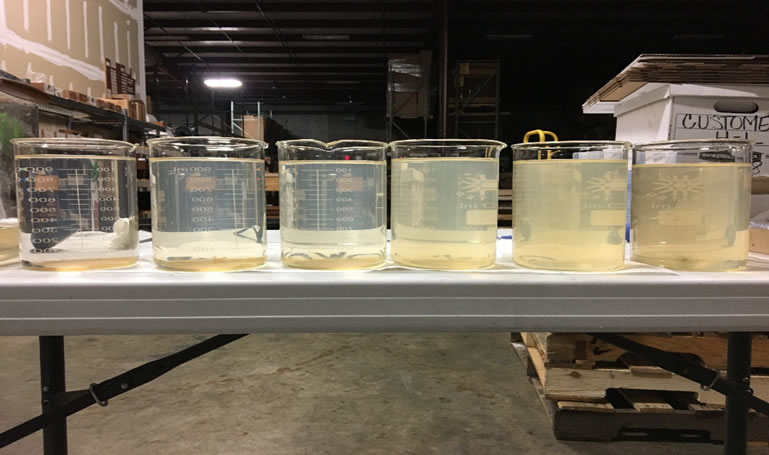What is Aluminum Sulfate?
Aluminum Sulfate, or alum, is a chemical that is very useful in the context of lake management. It is found in nature but can also be made in a lab very easily. It plays a role in several industries such as paper manufacturing and textile production, although one of the most common uses is in the water treatment industry as a coagulant. This process known as coagulation, or flocculation, is describing the physical accumulation of sediments in the water column with the alum. This accumulation will lead to larger particles which will sink to the bottom, resulting in clean, debris-free water. This process has proven to work on both small and large scale, which means aluminum sulfate use in ponds and lakes is a viable way to clear up your waterbody.
Uses and Benefits of Aluminum Sulfate
Due to the chemical makeup of alum, it will want to bind with a wide range of particles from clay sediment to nutrients such as nitrogen and phosphorus. When added to the water, the alum has a strong positive charge, and most raw water particles are negatively charged, so they bind very tight to each other. Fortunately, this chemical property solves two of the biggest problems pond owners have; eutrophication and clarity issues. In other words, waterbodies will accumulate and store whatever is washing into it, whether it be nutrients from fertilizer or clay particulates from runoff. Overtime your nutrient levels will become higher due to all the input with nothing balancing it out. Aluminum sulfate can essentially act as a reset button for your nutrient content, as well as any other sediment that might be floating in the water column. Conveniently, phosphorus and nitrogen are the two nutrients that algae and rooted plants rely on the most for growth. When the alum binds with these nutrients, it renders them useless, and if done correctly can prevent plant growth before it happens.
Precautions when applying Aluminum Sulfate
When applying alum, there are some parameters that need to be watched so we can be confident that the application will go smoothly. The first and most important tests you want to perform is the pH and alkalinity on the waterbody you are going to be applying the alum to. When mixed with water, one of the byproducts of the alum will be sulfuric acid. Alkalinity is a measurement of how well your water can buffer changes in ph. These tests ensure that when the application occurs, your waterbody’s pH will not plummet when the alum is applied, potentially stressing the fish in the pond. You want your pH to be from 6-8, and the Alkalinity to be 50-200 ppm (parts per million). If the alkalinity is too low, there are products available such as calcium carbonate that you can apply pre-treatment to raise it to the appropriate level.
Another test that is crucial to success is known as the jar test. This test can be performed at home with 4-6 glass jars, a syringe, and a stir bar. The purpose of this test is to calculate how much product will need to be added to your waterbody to adequately clear the water. First, you want to fill each glass jar with 1 liter of water. If you are trying to remove phosphorus from the water, you will want to buy phosphorus testing strips for each jar. Weigh out 10 grams of alum and thoroughly mix it with one of the jars. This creates a solution at 10 ppm of alum. You then take the syringe and add 2 ml of this solution to your first jar, making sure to leave one jar untouched as your control. You then go up by increments of .5 milliliters, until you run out of jars. So, you should have a 1-liter jar with 2 ml of the premade solution, one with 2.5 ml and so on. This should create a range of jars with different concentrations. Stir for several minutes and then let your jars sit for 24 hours. If the concentration reached the proper concentration, you should have at least one clear jar. If you are testing for phosphorus, simply test each concentration until the ppm has dropped to adequate levels. Why this test is crucial to success is because if you use less than the required amount, you will not achieve the desired results. Alternatively, if you use more than needed, you run the chances of wasting money and inflicting unneeded stress on your habitat. You can see an example of this in the picture below. If the concentration is not enough, you will still have turbid water and no noticeable effects will take place.
The jar test also serves another function that can prevent a headache with one simple observation. If done correctly, you should have one jar that is untouched pond water acting as your control. By leaving this jar undisturbed overnight, you are testing to see whether the particles settle or not. If they do, this tells you that there is something mechanical in the water stirring the particulates such as bottom dwelling fish or violent runoff. If this is the case, the alum will likely not solve your clarity issues as those forces will still be present. If the particles do not settle overnight, then that tells you it is a chemical imbalance in the water causing the particles to remain suspended. If this is your result, you are a prime candidate for an alum treatment.
Application of Aluminum Sulfate
Once you know your desired concentration and confirmed that your pond can adequately buffer the change in pH, you can prepare for application day. If you would like to be extra careful, you can take another pH and alkalinity reading right before the treatment, to ensure the levels are still where you want them. If you have an aerator, leave it on while you are treating the pond. To get the most out of your alum, you will want to premix your supply in a tank of water on a calm day. The premixed solution should be thoroughly agitated to ensure that the alum is free floating in the water. The most simple and common way to apply this solution is with a tank and a gas-powered trash pump. Use the pump to fill the tank with water, apply the alum, mix thoroughly, then use the pump to empty the tank into the waterbody. You will want to apply the alum solution proportionately to depth, applying more in the deeper areas. Shortly after applying, you should see what looks like a cloud forming under the surface of the water. This is that flocculation process previously discussed and is to be expected. If you have an aerator, turn it off once the application is complete and leave it off for at least three days. Expect to see results after 72 hours. If the pond doesn’t have much runoff and cycling water (i.e. several inlets or outlets), the results can last 10-12 years! If runoff is a problem, the treatment may only last 3-5 years, it just depends on your specific waterbody.
This product is most effective when applied as a slurry with water. If you do apply this product without pre-mixing the product is denser than water and will settle on the bottom. Ideally, you want the product to remain in the water column for several hours tying up excess phosphorus and sediment. Once on the bottom, it will tie up nutrients and sediment that are already resting but will not efficiently accumulate particles that are suspended.
Before and After Aluminum Sulfate Treatments
As one of our services, we offer alum treatments to local customers that are looking for a solution to high nutrient content or high turbidity. Here is a recent before and after look at how alum can benefit your pond both aesthetically and health-wise. Pre-application the visibility was 8”, whereas it was 3’2” following application.






